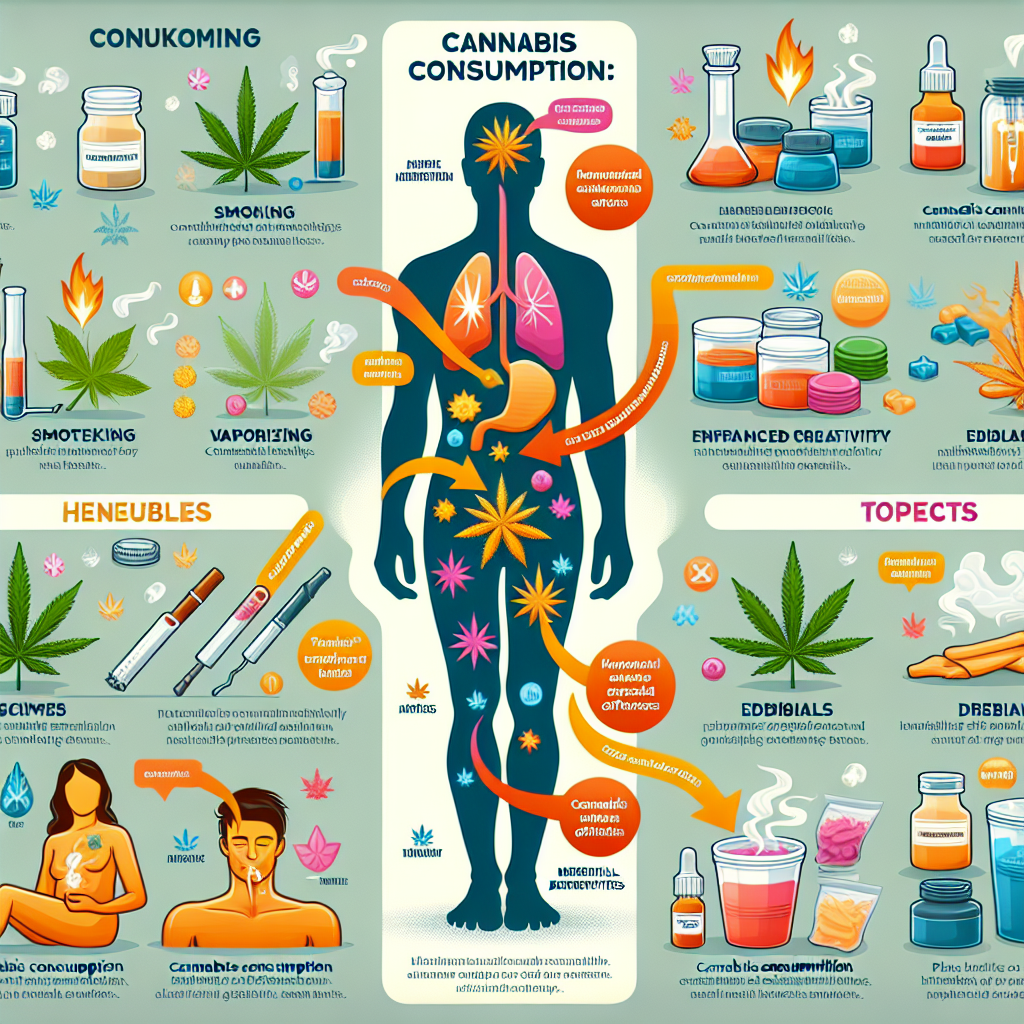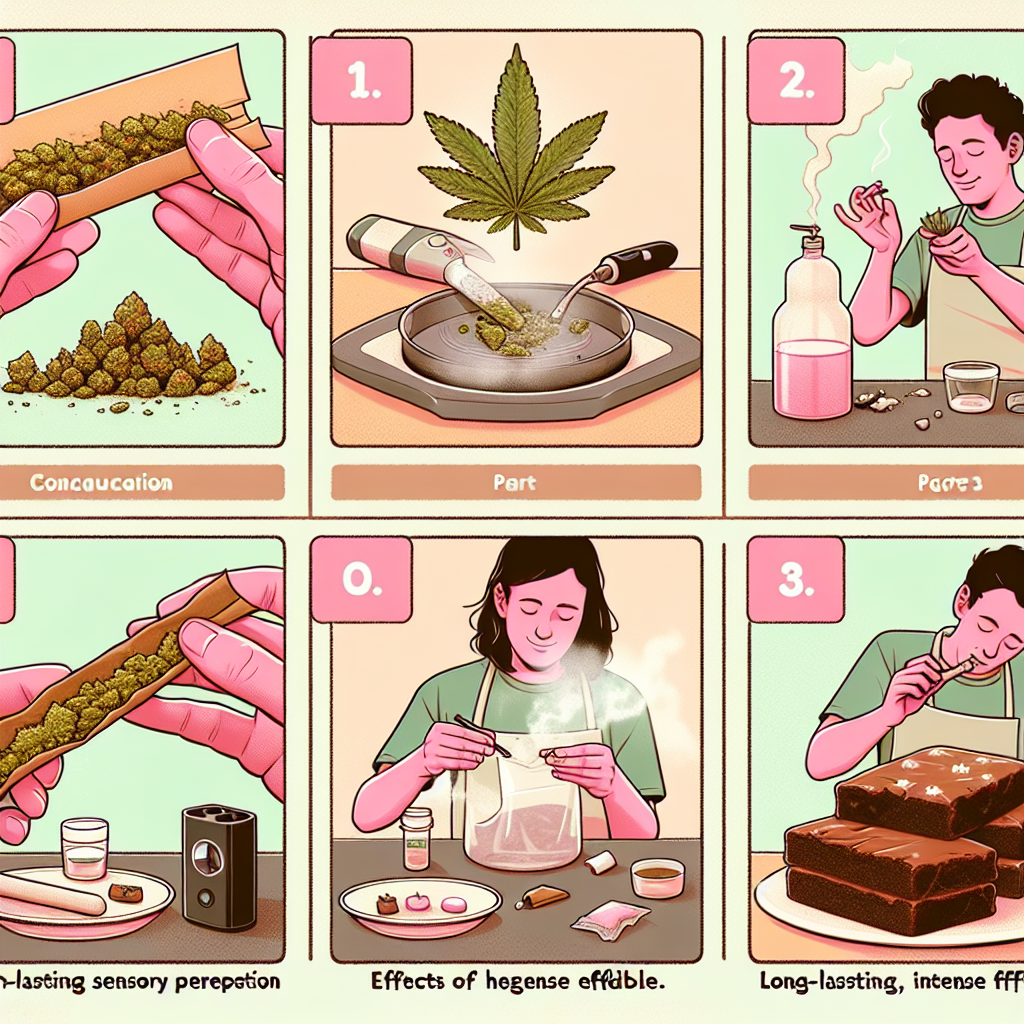Cannabis consumption has evolved significantly over the years, offering users a variety of methods to experience its effects. Each method of consumption can influence the onset, intensity, and duration of the effects, as well as the overall experience. The primary methods of cannabis consumption include smoking, vaping, edibles, tinctures, topicals, and dabbing. Smoking, the most traditional method, involves inhaling the smoke from burning cannabis flowers, providing rapid onset of effects. Vaping, a modern alternative, heats cannabis to release its active compounds without combustion, offering a potentially healthier option. Edibles, which involve ingesting cannabis-infused foods or beverages, result in a delayed but often more intense and longer-lasting experience. Tinctures, liquid cannabis extracts taken sublingually, offer a discreet and controlled dosage with relatively quick effects. Topicals, applied directly to the skin, provide localized relief without psychoactive effects. Dabbing, a method involving the inhalation of vaporized cannabis concentrates, delivers a potent and immediate experience. Understanding these different methods and their effects can help users make informed decisions based on their preferences and desired outcomes.
Smoking: Traditional Methods and Their Immediate Effects
Smoking cannabis is one of the most traditional and widely recognized methods of consumption. This method involves inhaling the smoke produced by burning the dried flowers of the cannabis plant. The immediate effects of smoking cannabis are often felt within minutes, making it a popular choice for those seeking quick relief or a rapid onset of effects. The process of smoking cannabis can be done in various ways, each with its own unique characteristics and nuances.
One of the most common methods of smoking cannabis is through the use of joints. A joint is essentially a hand-rolled cigarette that contains cannabis instead of tobacco. Rolling a joint requires a bit of skill and practice, but it is a favored method due to its simplicity and portability. When smoked, the cannabinoids, such as THC and CBD, are quickly absorbed into the bloodstream through the lungs, leading to almost immediate effects. These effects can range from a sense of euphoria and relaxation to increased creativity and sociability.
Another popular method is using a pipe or a bowl. Pipes come in various shapes and sizes, often made from materials like glass, metal, or wood. They are easy to use and provide a straightforward way to smoke cannabis. The process involves packing the bowl with ground cannabis, lighting it, and inhaling the smoke. Pipes offer a more controlled smoking experience compared to joints, as users can take smaller, measured hits. This method is particularly favored by those who prefer a more discreet and less wasteful way of consuming cannabis.
Bongs, also known as water pipes, are another traditional method of smoking cannabis. Bongs use water to filter and cool the smoke before it is inhaled, providing a smoother and often more potent hit. The water filtration process can help reduce some of the harshness associated with smoking, making it easier on the throat and lungs. Bongs come in various designs, from simple and functional to elaborate and artistic. The immediate effects of using a bong are similar to those of other smoking methods, but the intensity can be higher due to the larger volume of smoke inhaled in a single hit.
Transitioning from traditional methods, some users prefer blunts, which are cannabis cigars. Blunts are made by hollowing out a cigar or cigarillo and filling it with cannabis. The tobacco leaf wrapper adds a unique flavor and can enhance the overall smoking experience. However, it is important to note that the presence of tobacco also introduces nicotine, which can have its own set of effects and health considerations.
While smoking cannabis provides rapid onset of effects, it is not without its drawbacks. The combustion process produces smoke that contains harmful toxins and carcinogens, which can negatively impact lung health over time. Despite this, many users continue to prefer smoking due to its immediacy and the ritualistic aspect of the experience.
In conclusion, smoking remains a traditional and popular method of cannabis consumption, offering immediate effects that appeal to many users. Whether through joints, pipes, bongs, or blunts, each method provides a unique experience with its own set of characteristics. However, it is essential to be mindful of the potential health risks associated with smoking and to consider alternative methods if long-term health is a concern.
Edibles: Delayed Onset and Prolonged Impact

When it comes to consuming cannabis, edibles have become an increasingly popular choice for many users. Unlike smoking or vaping, which deliver cannabinoids almost instantly to the bloodstream through the lungs, edibles take a different route through the digestive system. This unique pathway results in a delayed onset of effects, which can catch some users off guard if they are not prepared for the wait. Typically, it can take anywhere from 30 minutes to two hours for the effects of cannabis edibles to be felt, depending on various factors such as metabolism, the type of edible, and whether it was consumed on an empty or full stomach.
One of the primary reasons for this delay is that the cannabinoids in edibles must first be processed by the liver before entering the bloodstream. During this process, delta-9-tetrahydrocannabinol (THC), the psychoactive component of cannabis, is converted into 11-hydroxy-THC, a compound that is known to be more potent and longer-lasting. This conversion can lead to a more intense and prolonged high compared to other methods of consumption. Consequently, users often experience a more profound and sustained effect, which can last anywhere from four to twelve hours, depending on the dosage and individual tolerance levels.
Given the delayed onset and prolonged impact of edibles, it is crucial for users to approach them with caution, especially if they are new to this method of consumption. It is not uncommon for individuals to become impatient and consume more edibles before the initial dose has taken effect, leading to an unexpectedly intense experience. To avoid this, it is recommended to start with a low dose, typically around 5 to 10 milligrams of THC, and wait at least two hours before considering an additional dose. This approach allows users to gauge their tolerance and avoid any unpleasant side effects such as anxiety, paranoia, or extreme sedation.
Moreover, the variety of edibles available on the market today is vast, ranging from gummies and chocolates to beverages and baked goods. Each type of edible can have a different onset time and duration of effects, so it is essential to read the packaging and understand the specific product being consumed. Additionally, homemade edibles can be particularly tricky, as it can be challenging to determine the exact dosage of THC in each serving. For this reason, many users prefer commercially produced edibles that offer consistent and reliable dosing information.
Another important consideration when consuming cannabis edibles is the potential for interactions with other substances. For instance, consuming alcohol in conjunction with edibles can amplify the effects of both substances, leading to increased impairment and a higher risk of adverse reactions. It is always wise to consume edibles in a safe and controlled environment, especially for those who are inexperienced or trying a new product for the first time.
In conclusion, while cannabis edibles offer a discreet and often enjoyable way to consume cannabis, they come with their own set of considerations. The delayed onset and prolonged impact require a patient and measured approach to dosing. By starting with a low dose and allowing ample time for the effects to manifest, users can enjoy the benefits of edibles without the risk of overconsumption. As with any method of cannabis consumption, being informed and cautious can lead to a more positive and enjoyable experience.
Vaping: A Modern Approach with Rapid Results
Vaping has emerged as a modern approach to cannabis consumption, offering users a rapid and efficient way to experience the effects of this versatile plant. Unlike traditional methods such as smoking, vaping involves heating cannabis to a temperature that releases its active compounds without burning the plant material. This process produces a vapor that can be inhaled, delivering cannabinoids like THC and CBD directly into the bloodstream through the lungs. As a result, the effects of vaping cannabis are felt almost immediately, making it an appealing option for those seeking quick relief or a fast-acting high.
One of the primary advantages of vaping over smoking is the reduced exposure to harmful toxins and carcinogens. When cannabis is smoked, the combustion process generates tar and other byproducts that can be detrimental to lung health. Vaping, on the other hand, heats the cannabis at a lower temperature, which minimizes the production of these harmful substances. This makes vaping a potentially safer alternative for individuals concerned about the long-term health effects of smoking.
Moreover, vaping offers a level of control and customization that is not typically available with other consumption methods. Many modern vaporizers come with adjustable temperature settings, allowing users to fine-tune their experience. Different cannabinoids and terpenes vaporize at different temperatures, so by adjusting the heat, users can target specific compounds to achieve their desired effects. For instance, lower temperatures may enhance the flavor and aroma of the vapor, while higher temperatures can produce a more intense and immediate high.
In addition to the health benefits and customization options, vaping is also known for its convenience and discretion. Portable vaporizers are compact and easy to carry, making them ideal for on-the-go use. The vapor produced is often less pungent and dissipates more quickly than smoke, which can be advantageous for those who prefer to consume cannabis without drawing attention. This discreet nature of vaping has contributed to its growing popularity among both recreational and medical cannabis users.
However, it is important to note that while vaping is generally considered safer than smoking, it is not without its risks. The quality of the vaporizer and the cannabis product used can significantly impact the overall experience and health outcomes. Poorly manufactured devices or low-quality cannabis extracts may contain harmful additives or contaminants. Therefore, it is crucial for users to invest in reputable vaporizers and source their cannabis from trusted suppliers to ensure a safe and enjoyable experience.
Furthermore, the rapid onset of effects associated with vaping can be a double-edged sword. While it provides quick relief, it also means that users need to be mindful of their dosage. It is easy to consume too much too quickly, which can lead to an overwhelming or uncomfortable high. Beginners are advised to start with a low dose and gradually increase it as they become more familiar with their tolerance and the effects of vaping.
In conclusion, vaping represents a modern and efficient method of cannabis consumption that offers numerous benefits, including reduced exposure to harmful toxins, customizable experiences, and convenience. However, users should remain cautious and informed about the quality of their devices and products to maximize the advantages while minimizing potential risks. As with any method of cannabis consumption, responsible use and awareness are key to a positive and safe experience.
Topicals: Localized Relief without Psychoactive Effects
Cannabis consumption has evolved significantly over the years, offering a variety of methods to suit different needs and preferences. One such method that has gained popularity is the use of topicals. These cannabis-infused products, which include creams, balms, and lotions, are applied directly to the skin. Unlike other forms of cannabis consumption, topicals provide localized relief without the psychoactive effects typically associated with THC. This makes them an appealing option for individuals seeking the therapeutic benefits of cannabis without the high.
Topicals work by interacting with the body’s endocannabinoid system (ECS), which plays a crucial role in regulating various physiological processes, including pain, inflammation, and skin health. When applied to the skin, the cannabinoids in topicals bind to the cannabinoid receptors in the epidermis and dermis layers. This interaction helps to reduce inflammation and alleviate pain in the targeted area. Consequently, topicals are often used to manage conditions such as arthritis, muscle soreness, and chronic pain.
Moreover, the non-psychoactive nature of topicals makes them suitable for a wide range of users, including those who may be sensitive to THC or who need to avoid its intoxicating effects for professional or personal reasons. This aspect is particularly beneficial for older adults or individuals with certain medical conditions who might be wary of traditional cannabis consumption methods. Additionally, because topicals are applied externally, they do not enter the bloodstream, further minimizing the risk of systemic side effects.
In addition to pain relief, cannabis topicals are also gaining recognition for their potential skincare benefits. Many topicals are formulated with additional ingredients such as essential oils, vitamins, and antioxidants, which can enhance their therapeutic properties. For instance, some products are designed to address skin conditions like eczema, psoriasis, and acne. The anti-inflammatory and antimicrobial properties of cannabinoids can help soothe irritated skin, reduce redness, and promote healing.
Furthermore, the market for cannabis topicals is expanding, offering consumers a diverse array of products to choose from. From transdermal patches that provide a steady release of cannabinoids over time to luxurious bath salts that combine relaxation with therapeutic benefits, there is something to suit every preference. This variety allows users to find the most effective product for their specific needs and lifestyle.
Despite the growing popularity of cannabis topicals, it is important to note that not all products are created equal. The quality and efficacy of a topical can vary significantly depending on factors such as the concentration of cannabinoids, the presence of other active ingredients, and the overall formulation. Therefore, it is advisable for consumers to do their research and choose products from reputable brands that provide third-party lab testing results. This ensures that the product contains the advertised amount of cannabinoids and is free from harmful contaminants.
In conclusion, cannabis topicals offer a unique and effective way to experience the therapeutic benefits of cannabis without the psychoactive effects. By providing localized relief, they cater to individuals seeking to manage pain, inflammation, and skin conditions in a targeted manner. As the market continues to grow, consumers can look forward to an increasing variety of high-quality products designed to meet their specific needs. Whether you are new to cannabis or a seasoned user, topicals present a versatile and user-friendly option worth exploring.
Q&A
1. **Question:** What are the primary methods of consuming cannabis?
**Answer:** The primary methods of consuming cannabis include smoking, vaping, edibles, tinctures, and topicals.
2. **Question:** How does smoking cannabis affect the body?
**Answer:** Smoking cannabis delivers cannabinoids directly to the lungs, where they are absorbed into the bloodstream, leading to almost immediate effects such as euphoria, relaxation, and altered sensory perception.
3. **Question:** What is the onset time and duration of effects for cannabis edibles?
**Answer:** The onset time for cannabis edibles is typically 30 minutes to 2 hours, with effects lasting anywhere from 4 to 12 hours, depending on the dose and individual metabolism.
4. **Question:** What are the benefits of using cannabis tinctures?
**Answer:** Cannabis tinctures offer a discreet, smoke-free method of consumption with a faster onset time than edibles (usually 15-45 minutes) and allow for precise dosing.
Conclusion
Cannabis consumption can be achieved through various methods, each with distinct effects. Smoking and vaping provide rapid onset of effects due to quick absorption into the bloodstream via the lungs, but they may pose respiratory risks. Edibles offer a delayed but prolonged experience as THC is metabolized in the liver, potentially leading to stronger psychoactive effects. Tinctures and oils allow for sublingual absorption, offering a middle ground with moderate onset and duration. Topicals provide localized relief without psychoactive effects, making them suitable for pain management. Each method’s efficacy and safety profile varies, necessitating informed choices based on individual needs and health considerations.


